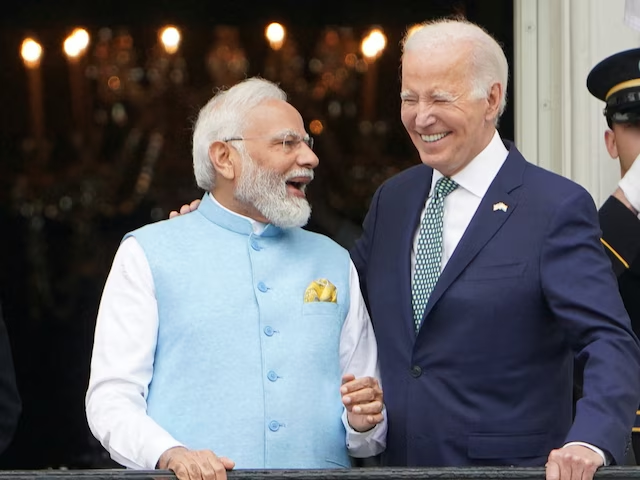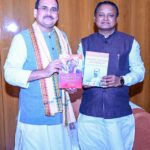A Proposed Semiconductor Plant And West Bengal’s Chance to Come Out of The Politics of Disruption
- By : Dr Anirban Ganguly
- Category : Articles

Prime Minister Narendra Modi recently announced, along with US President Joe Biden, the firming up of the deal for the semiconductor plant to be set up in Kolkata
In a week, Kolkata and West Bengal saw two major developments in terms of investment, industry, futuristic technology, and advancement. Prime Minister Narendra Modi announced, along with US President Joe Biden, the firming up of the semiconductor plant deal to be set up in Kolkata. Many observed that it was the first such big-ticket initiative in almost two decades. For a state that has seen politics of confrontation for the last five decades and running, this was indeed a major leap forward in trying to rescue Bengal from the unfortunate situation of continued de-industrialisation and a degenerating investment climate.
Five decades of militant trade unionism and political disruptions have contributed to this plight. The vision or belief of a synthesis or synchronicity between regional aspirations and national growth has been singularly absent in parties that have ruled the state for over five decades. Replying in Parliament on the motion of thanks to the President in February 2022, Prime Minister Modi said his fundamental belief was that there are no “conflicts between national progress and regional aspirations”. It is useful to recollect his words, that “India’s progress will be stronger when it addresses regional aspirations keeping in mind the development of the country. When our states progress, the country progresses”.
No leader had spoken in this manner in the past three decades. Most had resorted to the politics of conflict and confrontation. While many states have now realised the benefits of this view and mantra, West Bengal’s politics continues to be driven by a separatist and confrontationist mindset. The deal to set up the semiconductor plant in Kolkata and the commissioning of one of the PARAM Rudra Supercomputers for the Kolkata-based SN Bose National Centre for Basic Sciences thus came as a whiff of fresh air. It demonstrated PM Modi’s governance vision of a conflict-free trajectory of regional and national growth.
The PARAM Rudra Supercomputers are major milestones in India’s scientific quest and will boost research and development across various fields. It demonstrates India’s growing capacity for developing high-end advanced technology domestically. The supercomputer commissioned in Kolkata will promote advanced studies in cosmology, earth sciences, and physics. For a city which had once been home to some of the most advanced scientific minds in the country such as Acharya Prafulla Chandra Ray, Acharya Jagadish Chandra Bose, Dr SN Bose, Dr Meghnad Saha, to name a few, all of whom had made it their life-mission to reinstate India on the world’s scientific map, the supercomputer commissioning in Kolkata by PM Modi is a significant tribute.
Both leaders, PM Modi and President Biden, the White House ‘Joint Fact-Sheet’ states, “hailed a watershed arrangement to establish a new semiconductor fabrication plant focused on advanced sensing, communication, and power electronics for national security, next-generation telecommunications, and green energy applications. The leaders praised combined efforts to facilitate resilient, secure, and sustainable semiconductor supply chains including through GlobalFoundries’ (GF) creation of the GF Kolkata Power Center in Kolkata, India that will enhance mutually beneficial linkages in research and development in chip manufacturing and enable game-changing advances for zero and low emission as well as connected vehicles, internet of things devices, AI, and data centres”.
Indeed, it was a watershed development for India and more particularly for West Bengal. Experts have also argued that this deal is as powerful as the India-US nuclear deal which proved to be a redefining moment in the strategic relations between the two countries.
These hope-infusing developments come on the heels of the working paper ‘Relative Economic Performance of Indian States: 1960-61 to 2023-24’, released by the Prime Minister’s Economic Advisory Council (PM-EAC). The findings, especially to do with West Bengal, were indeed disconcerting. It spoke of West Bengal experiencing “a significant decline in relative per capita income”. It was a reality that most knew. The report did not articulate an unknown dimension. But it exposed a truth that the ruling TMC dispensation now and the Left dispensation in the past have refused to take note of. The economic decline of West Bengal was and is a result of the policies of these political formations effectuated over five odd decades.
The PM-EAC working paper noted how West Bengal, “which held the third largest share of national GDP at 10.5 per cent in 1960-61, now accounts for only 5.6 per cent in 2023-24”. There was a “consistent decline throughout this period”. Even in 1960-61, the state’s per capita income was above the national average at 127.5 per cent, “but its growth failed to keep pace with national trends” and its “relative per capita income declined to 83.7 per cent in 2023-24”, falling below that of even traditionally laggard states like Rajasthan and Odisha. The report points out how Maharashtra, West Bengal, and Tamil Nadu were home to India’s three largest industrial clusters in the 1960s. Over the years, while Maharashtra continued a steady growth at a steady pace and Tamil Nadu saw a pick-up in the 1990s after an initial phase of decline, West Bengal’s share has seen a steady decline.
The report also makes an interesting observation worth a deeper and more detailed probe, that of states with a long coastline, ‘maritime-states’, outperforming other states. Again, here too, West Bengal is the outlier, by not having been able to take advantage of this natural bounty. Whereas Odisha has seen improved growth in the last two decades.
In his once widely discussed study, ‘The Agony of West Bengal’, veteran journalist Ranajit Roy argued how from “the Battle of Plassey (June 23, 1757), the British ‘bled’ West Bengal, for a full one hundred and ninety years, one month and twenty-two days. The State surely had amazingly large resources and vitality to be able to emerge from that long dark period still buoyant, still full of optimism about her future. The people had been oppressed, exploited and impoverished. Yet, on the dawn of independence, she was producing, per head of the population, much more than any other state in the country. Considering her territory and population she was still the wealthiest state”.
Speaking of the amazing resilience of Bengal, Roy observed that “Britain’s first big achievement in Bengal was the great famine of 1770, the starting point of Bankim Chandra’s Anandamath”. While Britain’s parting gift to the province was the great famine of 1943. In this famine 15 lakh people perished, according to the official Woodhead Commission, and 34 lakh, according to the Calcutta University’s Anthropological Department [Tarak Chandra Das, Bengal Famine (1943): As Revealed in a Survey of the Destitutes in Calcutta, University of Calcutta, 1949].
“The second world war was on…Commodities were taken out of the province as from other parts of the country without giving anything in return…Bengal’s economy was shattered and her social and cultural fabric shaken to its foundation…And then came partition…Throughout the British period, many man-made calamities struck Bengal’s economic and social order. Every time she showed resilience and recovered thanks to the bounties of Nature and the abilities of her people,” he wrote.
Despite massive waves of adversities, in 1947, argued Roy, “West Bengal had the highest per capita income. In literacy, she yielded place only to Kerala. In installed electric power capacity and per capita consumption, she had a long march over the other States…She had access to industrial raw materials and had business connections and an infrastructure to make progress faster than any other State. Calcutta was the busiest city, and the port there handled much more cargo than even Bombay.”
Citing a study by the National Council of Applied Economic Research (NCAER) in 1967, Roy pointed out how in 1950, “West Bengal’s net domestic product was higher than that of every other State, even Maharashtra” and the “wealth that West Bengal produced per head of the population was considerably more than elsewhere”. While in industrial production West Bengal was “slightly behind Maharashtra but more than made this up in the field of trade and commerce in which West Bengal had a pre-eminent position. West Bengal’s net output in agriculture and allied sector was 25 per cent higher than Maharashtra’s.” In fact, Roy wrote, “No State other than UP, exceeded West Bengal’s output in this sphere.” UP was “more than three times as big in area and almost two and a half times as big in population as West Bengal”.
Flawed policies of the Congress at the Centre, and obstructionist policies of the Left Front and of the TMC in the state over the last five decades led to West Bengal’s decline. Mohan Dharia, then Minister of State for Planning, told the Rajya Sabha on May 12, 1972, “that the whole of West Bengal, except for Calcutta, Howrah, 24 Parganas districts, is now being treated as backward”. Roy lamented that this was the “fate in independent India of the state which was most advanced in industry, agriculture, commerce and cultural activities and had the highest per capita production and income in 1947”. None of these parties and their leaders and legacies can escape the blame for West Bengal’s decline. Posterity will judge them harshly.
Meanwhile, the proposed semiconductor plant can prove to be a game-changer to start with. Besides this, in the last decade PM Modi has kept his focus on the growth and rejuvenation of West Bengal. His vision of Purvoday, articulating a roadmap for the multi-sectoral rise of eastern India, can be a transformative proposition for West Bengal. But today’s rulers in West Bengal adhere to a zamindari mindset, they want to go it alone. Their false pride has greater priority than West Bengal’s growth. But just by taking recourse to slogans and claptrap on West Bengal’s glory and Bengali pride, the state will not see growth and prosperity. For that to be realised, what is needed is an action-oriented mindset which will respond to PM Modi’s call of Purvoday. That way lies West Bengal’s chance for a comprehensive rebooting in our times.

















